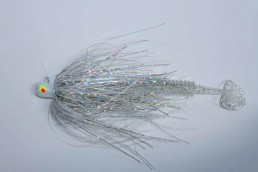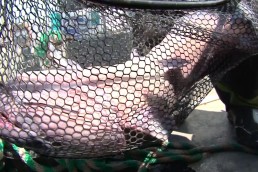Big Fish go for Flash They Like to Bash
SHARE THIS POST
We had a nice school of white bass all to ourselves. It was chaos on Lake Poygan too, with trucks and people driving around like the state fair was happening. Our guide Troy Peterson had had enough of the crowds and we pushed shallow, near some reeds. We drilled and tested out a dozen holes until a school of whiteys were found. Then, it was game on as white bass after white bass came through the hole.
Then all of a sudden, it just quit.
“Probably a big pike in the area,” Troy lamented.
Luckily, we had our trusty 1/4-ounce Slender Spoons rigged and ready. Nickel with a glow center mimicked the white bass just fine. Watching the spoon on the Humminbird was like watching an out-of-control clock, as fast flashes appeared right before the rod bent over.
“Yippee-Ki-Yay!” yelled “Cowboy Kevin,” as line screamed from his reel.
Pike were ripping drag on two of our poles before Troy could even get a tip-up out of the sled. So, he grabbed a pole, a Slender Spoon and auger, and then headed even shallower.
It didn’t take long before he had one of his own.
Are you enjoying this post?
You can be among the first to get the latest info on where to go, what to use and how to use it!
Flash and attraction is what makes a spoon great. The flash calls fish in from a distance, yet needs a little extra something to get them to hit. It might be color, a unique bend or the addition of a plastic or bait on a hook.
Feeding fish attract other fish. When they are feeding—big predators like pike, lake trout and walleyes—there are flashes underwater as scales are flying with a lot of action.
Trout offer a lot of this action and the lake trout, king salmon, steelhead and brown trout will inhabit the harbors of the Great Lakes all winter into February. These monsters are really attracted to flashy tinsel. It’s the same in the open water too, as a salmon fly made from tinsel is awesome when trolled.
Since it’s hard (obviously) to troll under the ice, one great delivery system for flash is a jig. B-Fish-N Tackle’s new MasterFlash jig has a glittered jig head and over 300 strands of 1/69-inch holographic tinsel and pulses and flashes when jigged. On a pause, the tinsel flares out and undulates like a fish flaring its gills.
Last winter, we tested some of the new MasterFlash jigs tipped with some new AuthentX Fire Ice Pulse-Rs on lake trout in the Canadian waters. Depths of 80 to 120 feet requires thin braided line with no stretch to get down quick. And to set the hook, a stiff rod and a heavy weight is used. The 5/8-ounce MasterFlash got down quick and got the lakers’ attention, which can be hard to do. Usually, you might only catch one out of 10 that pop up on a flasher. Trophy fish might pop up out of nowhere and stare at an offering for a long time. I’ve had lakers and walleyes staring for 15 minutes while I dared not make a stupid move. And then, all of the sudden, the rod bends. A good flasher or underwater camera is important in figuring out just what the heck is going on down there.
Our last big-fish bait is an RPM size 5. This larger version has done well for us on oversized walleyes on the Great Lakes, in Canada, Minnesota and Wisconsin. Banging the bottom with these is effective whether you’re clicking on rocks or puffing up a soft bottom, and, the noise and the nosedive on these baits resembles a fish fleeing.
Sometimes those big walleyes will suspend. A constant jigging motion followed by a five-second pause is then a standard technique. We’ve been with a group of guys and when one catches a fish, everyone is all over him asking what he did. Sometimes the best motion is no motion as you stare at the big red band on a flasher and not move a muscle.
MWO
SHARE THIS POST
Did you enjoy this post?
You can be among the first to get the latest info on where to go, what to use and how to use it!
Walt Matan
Walt Matan has been a writer and television host for MidWest Outdoors for 30 years. An avid ice and open-water fisherman, he currently lives in the Quad Cities on the shores of the Mississippi River. He is the product developer and brand manager for Custom Jigs & Spins, B-Fish-N Tackle, and Rippin Lips Catfish Tackle. For more information visit customjigs.com.


